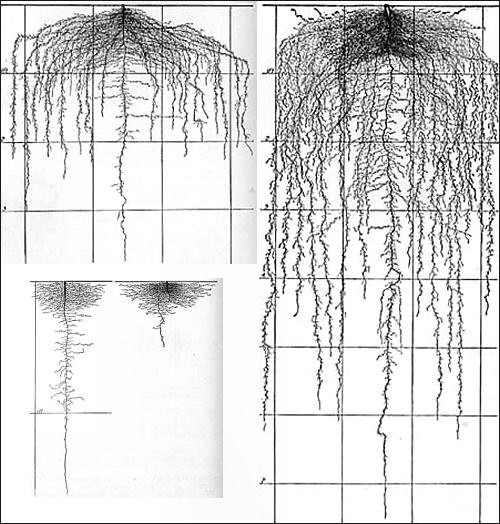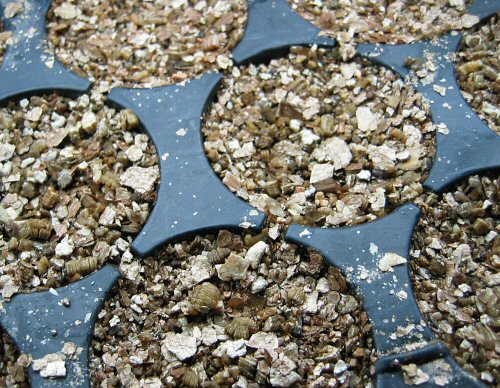- Root love
- Potato fruit
- Row cover mystery
- Big, ugly, quite tasty
- Exploring down below…
- The joy of decay…

These technical drawings of a lettuce root system are from Root Development of Vegetable Crops*, first published in 1927 and now in the public domain. This is an incredible book that I just discovered. The text is like a complete gardening course delivered from underground. Over 30 North American common garden veggies are covered, a chapter each. The drawings record direct observation, the result of years of root excavation.
I can hardly describe how satisfying and…enlightening it is to simply look at page after page of painstakingly drawn root systems! Here, the top two pictures are lettuce at two months and then at three months and flowering. Each square in the grid is one foot. The little side-by-side illustratation shows 3-week-old seedlings, grown on the left in loose soil (nearly 2′ down!!), on the right in compacted soil (and to think, I have 3-week seedlings in tiny plug sheet cells, 2-1/2″ deep!). One look at this and your mind expands!
*I downloaded it from the fantastic Soil & Health Holistic Agriculture Library, an online repository for numerous excellent books, mostly from 1910-1960, and all entirely free—there are many organic farming classics, tons of great, practical stuff!




Hi Mike – what a fantastic find!
Yes, awesome. I am adding that site to my library-building link library. I have recently stumbled on a few other sites that have PDF texts of many pubic domain books, including cookbooks from the 1600’s (translated).
I was just thinking about (and writing about) mathematical formulas found in nature (fractals and broccoli romanesco to be exact) — and while doing a little poking around on the internet I came across some sources stating that the root systems of many trees grow in fractals — crazy! I wonder if the book has any observations of that in vegetable root systems? What a neat resource.
Thanks for the tip-off about the online library. I love old gardening books. The similarities and differences are fascinating in equal measure. I can hardly believe someone had the patience to so painstakingly map all those vegetable roots … that’s one heck of an undertaking.
Hey Mike
thanks from us too. Very interesting – we were particularly excited to see that mature swiss chard has a strong tap root which penetrates 6 to 7 feet. We got swiss chard all over our plot and we are in desperate need of better drainage/aeration.
Thanks again
keener and beener
A lot of thanks for every one of your effort on this web site. My mum delights in doing investigations and it’s obvious why. Almost all hear all about the compelling tactic you produce useful items through this web blog and in addition foster contribution from visitors on that area of interest and my simple princess is in fact discovering a lot of things. Have fun with the remaining portion of the year. You are performing a powerful job.